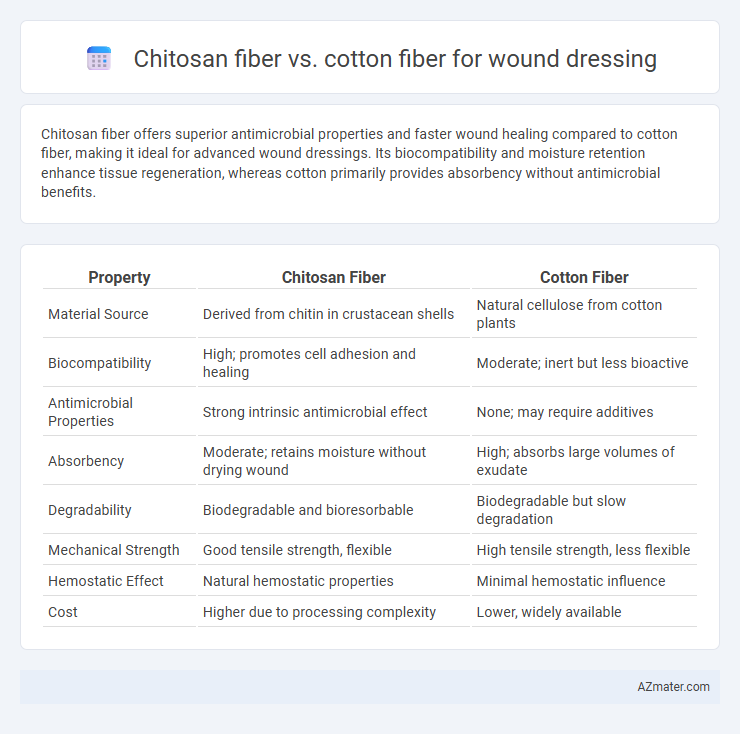Chitosan fiber offers superior antimicrobial properties and faster wound healing compared to cotton fiber, making it ideal for advanced wound dressings. Its biocompatibility and moisture retention enhance tissue regeneration, whereas cotton primarily provides absorbency without antimicrobial benefits.
Table of Comparison
| Property | Chitosan Fiber | Cotton Fiber |
|---|---|---|
| Material Source | Derived from chitin in crustacean shells | Natural cellulose from cotton plants |
| Biocompatibility | High; promotes cell adhesion and healing | Moderate; inert but less bioactive |
| Antimicrobial Properties | Strong intrinsic antimicrobial effect | None; may require additives |
| Absorbency | Moderate; retains moisture without drying wound | High; absorbs large volumes of exudate |
| Degradability | Biodegradable and bioresorbable | Biodegradable but slow degradation |
| Mechanical Strength | Good tensile strength, flexible | High tensile strength, less flexible |
| Hemostatic Effect | Natural hemostatic properties | Minimal hemostatic influence |
| Cost | Higher due to processing complexity | Lower, widely available |
Introduction to Wound Dressing Materials
Chitosan fiber and cotton fiber are widely used materials in wound dressing due to their biocompatibility and moisture management properties. Chitosan fiber offers antimicrobial activity, promoting faster healing and reducing infection risk, while cotton fiber provides excellent absorbency and breathability, crucial for maintaining a moist wound environment. Understanding the differences in biodegradability, mechanical strength, and bioactivity is essential for selecting the optimal dressing material based on wound type and healing requirements.
Overview of Chitosan Fiber
Chitosan fiber, derived from chitin in crustacean shells, exhibits excellent biocompatibility, biodegradability, and antimicrobial properties, making it highly suitable for wound dressing applications. Unlike cotton fiber, chitosan aids in hemostasis, accelerates wound healing, and reduces infection risks due to its natural antibacterial activity. Its ability to maintain a moist environment and promote cell regeneration enhances tissue repair more effectively compared to traditional cotton fibers.
Overview of Cotton Fiber
Cotton fiber, derived from natural cellulose, is widely used in wound dressings due to its high absorbency, softness, and breathability, facilitating effective moisture management and patient comfort. Its natural origin ensures biocompatibility and hypoallergenic properties, reducing the risk of irritation and allergic reactions during wound healing. However, cotton lacks inherent antimicrobial properties, which makes it less effective in preventing infections compared to fibers like chitosan.
Biocompatibility of Chitosan vs Cotton
Chitosan fiber exhibits superior biocompatibility compared to cotton fiber, promoting enhanced cell adhesion, proliferation, and accelerated wound healing due to its natural antimicrobial and anti-inflammatory properties. Unlike cotton, chitosan is biodegradable and does not induce significant immune responses, reducing the risk of allergic reactions and inflammation in wound dressings. These characteristics make chitosan fiber an ideal material for wound care applications, providing a favorable environment for tissue regeneration and infection control.
Antimicrobial Properties Comparison
Chitosan fiber exhibits superior antimicrobial properties compared to cotton fiber due to its inherent positive charge, which disrupts bacterial cell membranes and promotes wound healing. Unlike cotton, which lacks intrinsic antimicrobial activity and often requires chemical treatment to prevent infection, chitosan provides a natural, biocompatible barrier against a broad spectrum of pathogens. This makes chitosan fibers particularly effective in reducing infection rates and enhancing tissue regeneration in wound dressing applications.
Absorption and Moisture Management
Chitosan fiber exhibits superior absorption compared to cotton fiber due to its high porosity and hydrophilic nature, enabling efficient uptake of wound exudate while maintaining a moist environment conducive to healing. Its inherent antimicrobial properties coupled with controlled moisture retention prevent bacterial growth and reduce infection risk. Cotton fiber, although breathable and soft, tends to absorb moisture less effectively and may retain excess fluid, leading to prolonged wound wetness and delayed healing.
Biodegradability and Environmental Impact
Chitosan fiber exhibits superior biodegradability compared to cotton fiber, breaking down more rapidly in natural environments due to its polysaccharide composition derived from crustacean shells. This accelerated biodegradation minimizes environmental impact by reducing landfill accumulation and supporting sustainable waste management. Cotton fiber, although natural and biodegradable, decomposes slower and requires intensive agricultural inputs, increasing its overall ecological footprint.
Mechanical Strength and Flexibility
Chitosan fiber exhibits superior mechanical strength compared to cotton fiber, providing enhanced durability and resistance under stress, which is critical for wound dressing applications. Its intrinsic flexibility allows it to conform better to wound contours, offering improved comfort and adaptability during movement. Cotton fiber, while breathable and soft, generally lacks the tensile strength and elasticity of chitosan, making it less optimal for dynamic wound environments requiring robust protection.
Clinical Effectiveness in Wound Healing
Chitosan fiber demonstrates superior clinical effectiveness in wound healing compared to cotton fiber due to its inherent antimicrobial properties, biocompatibility, and ability to accelerate hemostasis. Multiple clinical studies highlight chitosan's capacity to reduce infection rates and promote faster epithelialization in acute and chronic wounds. In contrast, cotton fiber serves primarily as a passive absorbent with limited bioactive benefits, making chitosan fiber a more advanced choice for enhanced wound dressing outcomes.
Future Prospects and Market Trends
Chitosan fiber is gaining significant attention in wound dressing due to its superior antimicrobial, biocompatible, and biodegradable properties, positioning it as a promising alternative to traditional cotton fiber. The global market for chitosan-based wound dressings is projected to grow substantially, driven by increasing demand for advanced, infection-resistant materials in healthcare. Innovations in nanotechnology and bioengineering are expected to enhance the efficacy and functionality of chitosan fibers, further expanding their application and market share in the wound care industry.

Infographic: Chitosan fiber vs Cotton fiber for Wound dressing
 azmater.com
azmater.com